What is good about the Dwarf basil variety: reviews of those who grew it, advantages and disadvantages
Basil Dwarf is not only a spice, but an ornamental plant. Each housewife will be able to grow it on her windowsill, following the simple rules of planting and care. The article will tell you what its features and advantages are over other varieties and how to properly grow it on the site in order to get a rich harvest of aromatic spices.
The content of the article
What is this kind of basil
Dwarf is a mid-early basil variety. It has small rounded green to purple leaves, small purple flowers. The full growing season from sowing seeds to harvesting is 55-60 days.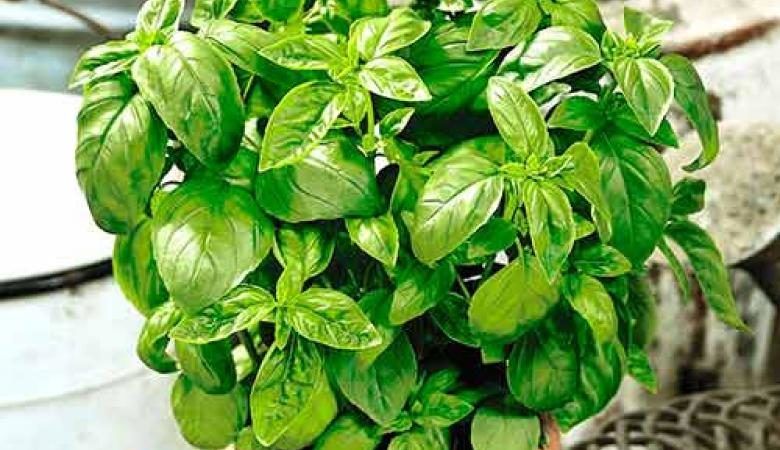
Brief history of origin and distribution
Basil became popular in Europe at the end of the 19th century. Prior to that, it was known only in the Middle East. For the first time in Europe, chefs from Greece, then Italy, and France began to use it. It is used to prepare spices, sauces for meat and fish dishes.
The plant reaches a height of no more than 35 cm - hence the name of the variety.
Fact! The dwarf is included in the State Register of Russia in 2006 and is recommended for growing in personal subsidiary plots.
Differences from other varieties
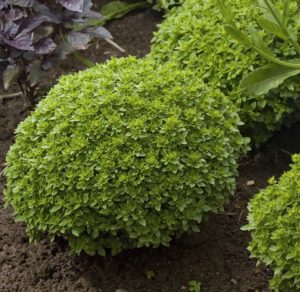
The main differences from other varieties:
- compact, low bush - grows in height from 10 to 35 cm;
- grown as an ornamental flower;
- differs in small leaves with a bluish-green color, collected in a spherical bush.
The yield of the variety is from 1.2 to 1.4 kg of greenery per 1 m².
Feature and Description
Basil variety Dwarf has three varieties:
| Name | Description | Features: |
|---|---|---|
| Dwarf green | Small bushes 10-18 cm high. Leaves are green, spherical. | Has a clove-peppery aroma. |
| Dwarf greek | Bush 25-30 cm high. Green leaves, small in size. | Anise flavor and strong, persistent aroma. |
| Dwarf purple | The height of the bush is 30-35 cm. Small purple-colored leaves are collected in a neat bush. | Strong peppery aroma and taste. |
Features of the chemical composition
Basil leaves contain many micro and macro elements useful for the human body:
- vitamin B2 - 0.076 mg;
- B4 - 4 mg;
- B5 - 0.209 mg;
- B6 - 0.155 mg;
- C - 18 mg;
- potassium - 295 mg;
- calcium - 177 mg;
- magnesium - 64 mg;
- phosphorus - 56 mg;
- iron - 3.17 mg;
- manganese - 1.148 mg.
Fresh basil leaves in the salad perfectly tone up and improve digestion. 100 g of leaves contain 23 kcal, which allows those who want to lose weight to use them.
The basil contains:
- proteins - 3.15 g;
- fats - 0.64;
- carbohydrates - 1.05 g.
Persistence
A distinctive characteristic of the Karlik variety is its resistance to diseases, for example, black leg, gray rot, fusarium. The plant tolerates heat (over + 20 ... + 25 ° C), but does not like drafts.
On a note! Poorly tolerates sudden drops in air temperature.
Scope of the variety
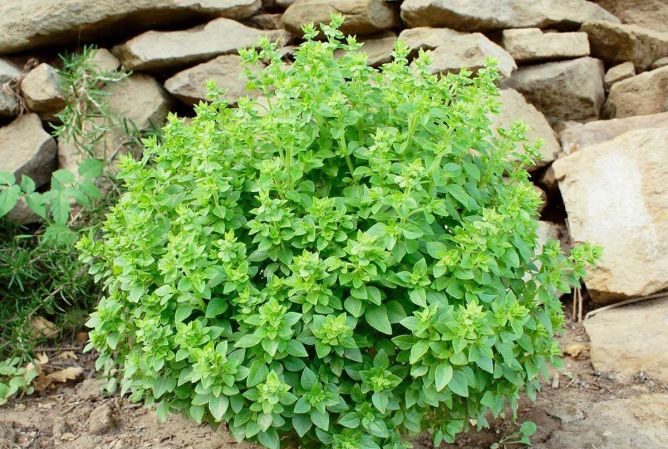
The Dwarf variety has a clove-pepper, aniseed aroma, has a peppery, spicy taste:
- fresh used for making salads, diet cocktails, for canning;
- in dried form - as an additive to spices for meat, fish, first and second courses.
Found application in gardening, landscape design as an ornamental plant with purple flowers. It is planted in open ground and pots on the windowsill.
Read also:
Is it possible to plant basil before winter and how to do it
Growing technology
For the successful cultivation of dwarf basil at home, a number of conditions are met:
- They monitor the soil moisture and prevent waterlogging. Excessive humidity provokes parasite infestation and the development of diseases.
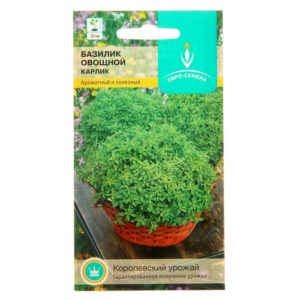
- For basil, a ready-made fertile earthen mixture with peat, which is sold in a specialized store, is suitable.
- The optimum temperature for growing a plant is + 18… + 25 ° C. If the temperature drops below + 15 ° C, then basil slows down growth. When lowered to + 12 ° C, the spice completely loses its taste and dies.
- The light regime in the summer is 16-17 hours. Provide additional artificial lighting in autumn and winter.
- Pinching the growing basil is carried out to increase the number of shoots and leaves.
Terms and rules of landing
Sowing seeds for seedlings in prepared boxes or pots is carried out from 10 to 20 April. Sowing depth of seeds - no more than 1 cm.
- In the boxes, grooves are made at a distance of at least 5 cm from each other.
- Sow seeds and sprinkle with soil.
- Water from a spray bottle.
At the beginning of summer (June 1-10), in central Russia, basil seedlings are planted in open ground. Landing scheme 20x30. Planting depth - 5-7 cm.
Important! Basil variety Dwarf loves sunny open areas.
Further care
Basil is watered as the soil dries up. Use warm (+ 30 ° C) settled water. Sprouted seedlings are sprayed daily with water from a spray bottle. Young seedlings on the site need watering in hot weather 2 times a day - in the morning and in the evening.
Top dressing of seedlings is carried out once within 2 weeks:
- Mineral fertilizer is applied to the soil 10-14 days after planting for rooting and greenery.
- Infusion of cow or chicken manure - 0.5 liters per 10 liters of water.
- Agrolife - 1 tsp. for 1 sq. m of land.
Loosening and weeding is an important part of basil care. Loosening enriches the soil with oxygen, facilitates the penetration of air to the roots. Weeding prevents weeds from stunting the plant.
On a note! A blooming basil bush is not edible, so pinch off the top after the fourth leaf appears and cut off the branches.
Possible problems, diseases, pests
Basil Dwarf is susceptible to diseases if one of the growing conditions is violated:
- Gray mold - appears from strong waterlogging of the soil. The plant withers, red spots appear on the leaves. Spray with infusion of onion peel - 100 g per 400 ml of boiled water insist for a day.
- Fusarium - a dangerous fungal disease, from which the plant dies. The leaves turn yellow, the trunk becomes thinner, the root rots. For treatment, use "Phytocide", "Fitosporin-M".
- Blackleg - affects young seedlings, root stalk rots, arises from abundant watering. They are treated with "Alirin-B", "Gamair" preparations.
Pests dangerous for basil are bugs, aphids. To combat them, use a decoction of wormwood, tansy. Prepared at the rate of 1 liter of herb infusion per 5 liters of water, sprayed 2-3 times a week. When a spider mite appears, spray it with Fitoverm.
Features of growing by seeds / seedlings
Presowing preparation of basil seeds consists in warming up and stimulating growth. Place them in a warm place, such as a battery, 1-2 weeks before planting. Then wrap in damp gauze for a day so that the seeds wake up and hatch. Soak in Epin growth stimulating solution for 24 hours.
In the ground
It is not recommended to sow the dwarf basil variety in the open ground with seeds. For this, seedlings are used:
- The land for planting is fertilized in advance, organic fertilizing from deciduous compost is introduced, dug up and cleaned the site of weeds and rhizomes.
- They make holes 5-7 cm deep, plant seedlings at a distance of 10-15 cm from each other.
- Watered with warm, settled water and sprinkle the roots of the plant with earth.
In the greenhouse
After the appearance of 2 true leaves, the basil seedlings are planted in a greenhouse. For this, a pick is made. The tip of the root is removed so that the plant has strong lateral roots. Seeding pattern - 20x30 cm.
Seedling care in the greenhouse:
- Daily spraying from a spray bottle and drip irrigation.
- Airing for 2-3 hours a day for hardening.
- Pinching the top of the basil to stimulate the growth of side shoots and foliage.
At home
Planting seeds at home is carried out in pots with prepared soil:
- The bottom of the pot should be with drainage - pebbles, expanded clay or small stones.
- The pot is filled with soil, not filling up to the top by 4-5 cm, and moistened.
- Seeds are sown at a distance of 2-3 cm from each other, sprinkled with earth by 1 cm.
- Cover the pot with clear glass or plastic to create a mini greenhouse. Put in a warm place.
- With the appearance of the first shoots, the seedlings provide light, open and ventilate the greenhouse every day.
- After 10-14 days, the glass is removed. Seedlings are thinned if necessary.
Advantages and disadvantages of the variety
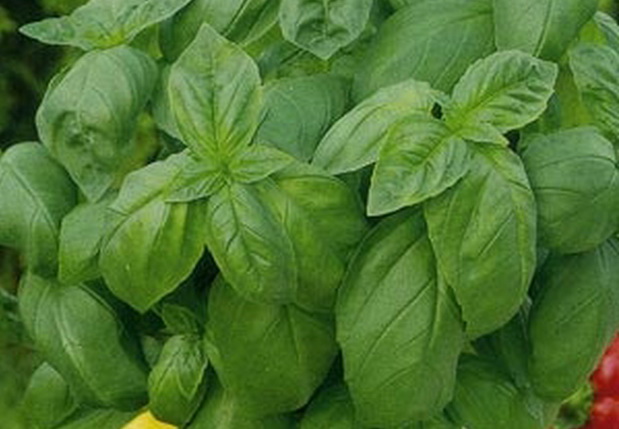
The main advantages of the Karlik variety:
- use as a seasoning for any dishes;
- a beautiful decorative flower that does not require complex maintenance;
- small growth allows you to grow it on the balcony, in a flower pot.
The disadvantage is early flowering. Therefore, you should constantly monitor the shoots and remove flowers if you want to get leaves for seasoning.
Reviews of summer residents
To make sure that the variety is chosen correctly, it is worth asking the opinion of those who have already grown it at home or on the site.
Antonina, Dnipro: “I liked the variety of the Basil Dwarf for its beauty, it grows in a small bush, does not require special care. The second year I plant it in a flower pot. There is always fresh herbs on hand for seasoning. "
Svetlana, Syktyvkar: “We have cold winters, spring comes late, but I want something fresh, green. Therefore, I grow Dwarf basil on the balcony along with parsley, dill. Small leaves, densely dotted on the branches, look very beautiful in my little greenhouse. "
Read also:
When to harvest and how to dry basil properly.
Plant compatibility: what to plant next to basil and why it is important.
How to properly freeze basil for the winter: a selection of the best ways.
Conclusion
The Dwarf vegetable basil variety is great for growing at home. A small bush looks beautiful on the windowsill in the kitchen and pleases the whole family with fresh greens. Unpretentious care, pleasant aroma and delicate taste made it indispensable in the preparation of various dishes.